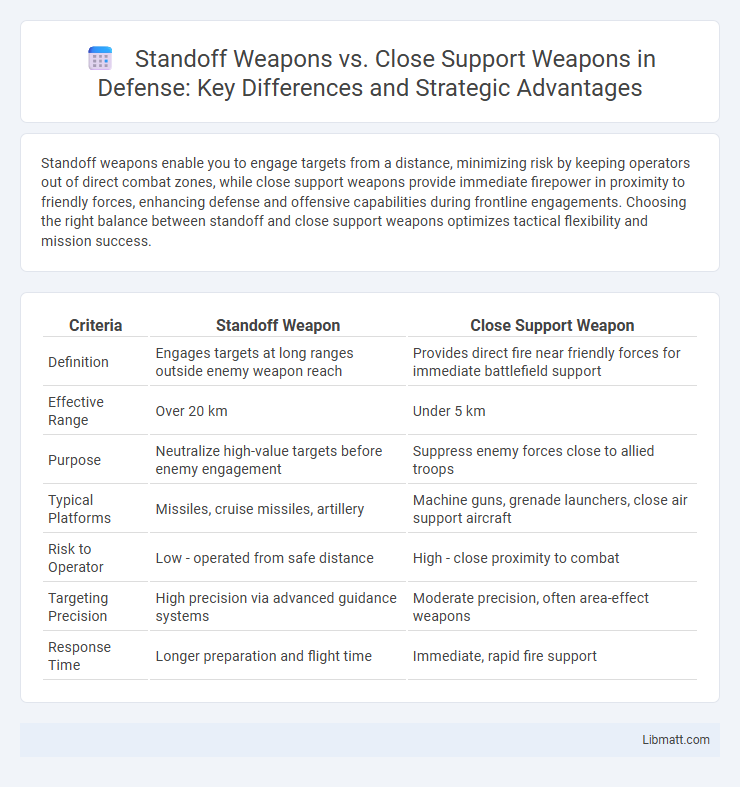Standoff weapons enable you to engage targets from a distance, minimizing risk by keeping operators out of direct combat zones, while close support weapons provide immediate firepower in proximity to friendly forces, enhancing defense and offensive capabilities during frontline engagements. Choosing the right balance between standoff and close support weapons optimizes tactical flexibility and mission success.
Table of Comparison
| Criteria | Standoff Weapon | Close Support Weapon |
|---|---|---|
| Definition | Engages targets at long ranges outside enemy weapon reach | Provides direct fire near friendly forces for immediate battlefield support |
| Effective Range | Over 20 km | Under 5 km |
| Purpose | Neutralize high-value targets before enemy engagement | Suppress enemy forces close to allied troops |
| Typical Platforms | Missiles, cruise missiles, artillery | Machine guns, grenade launchers, close air support aircraft |
| Risk to Operator | Low - operated from safe distance | High - close proximity to combat |
| Targeting Precision | High precision via advanced guidance systems | Moderate precision, often area-effect weapons |
| Response Time | Longer preparation and flight time | Immediate, rapid fire support |
Introduction to Standoff and Close Support Weapons
Standoff weapons enable engagement of targets from long distances, enhancing safety and precision by minimizing exposure to enemy fire. Close support weapons provide direct firepower in proximity to friendly forces, crucial for suppressing threats during ground operations. Both weapon types are essential for balanced combat strategies, offering complementary capabilities in various tactical scenarios.
Defining Standoff Weapons
Standoff weapons are precision-guided munitions designed to engage targets from long distances, minimizing the exposure of launch platforms to enemy defenses. These weapons rely on advanced targeting systems and GPS or inertial navigation to strike high-value targets while remaining outside the range of enemy fire. By contrast, close support weapons operate within closer proximity to friendly forces, providing direct fire with rapid response to dynamic combat situations.
Defining Close Support Weapons
Close support weapons are designed for direct engagement with enemy forces in proximity to friendly units, providing immediate firepower to suppress or neutralize threats on the battlefield. Unlike standoff weapons, which operate from a distance to avoid exposure, close support weapons include systems like machine guns, grenade launchers, and infantry fighting vehicles that enable rapid response and flexibility in dynamic combat scenarios. Your effective utilization of close support weapons enhances troop survivability and mission success by delivering precise, timely fire where it is most needed.
Key Differences in Operational Range
Standoff weapons are designed to engage targets from long distances, often beyond the immediate threat zone, providing strategic advantage by minimizing risk to the operator. Close support weapons operate within shorter ranges, delivering rapid and accurate firepower to assist ground forces in direct combat situations. Your choice between these depends heavily on the mission's required engagement distance and tactical environment.
Applications in Modern Warfare
Standoff weapons, such as precision-guided missiles and long-range artillery, enable forces to engage targets from a safe distance, minimizing exposure and maximizing strategic impact in modern warfare. Close support weapons, including machine guns and rocket-propelled grenades, provide immediate firepower to protect ground troops during urban combat and fast-paced operations. Your choice between these weapon types depends on mission parameters, emphasizing long-range suppression or direct troop engagement.
Precision and Guidance Technologies
Standoff weapons utilize advanced precision and guidance technologies such as GPS, inertial navigation systems, and laser designators to engage targets accurately from long distances, minimizing risk to operators. Close support weapons rely more on direct line-of-sight targeting and often incorporate rapid-fire capabilities with less emphasis on advanced guidance systems, prioritizing immediate response and maneuverability in proximity to friendly forces. Your choice depends on tactical needs, where standoff weapons offer enhanced precision for distant threats, while close support weapons provide reliable, precise firepower in dynamic combat environments.
Survivability and Risk Factors
Standoff weapons enhance survivability by allowing forces to engage targets from a distance, minimizing exposure to enemy fire and reducing the risk of casualties. Close support weapons require operators to be near the frontline, increasing vulnerability to direct attacks and battlefield hazards. The choice between standoff and close support weapons significantly impacts the operational risk profile and force protection measures.
Impact on Mission Effectiveness
Standoff weapons enhance mission effectiveness by allowing forces to engage targets from a distance, reducing exposure to enemy fire and increasing operational safety. Close support weapons improve mission adaptability and accuracy by providing immediate, precise firepower in proximity to friendly troops, facilitating rapid response to dynamic battlefield conditions. The combination of both weapon types optimizes overall mission success by balancing reach with tactical responsiveness.
Cost and Logistics Considerations
Standoff weapons typically involve higher costs due to advanced guidance systems and longer-range capabilities, increasing procurement and maintenance expenses. Close support weapons are generally more affordable and easier to deploy, requiring less specialized logistics and supporting quicker resupply in dynamic combat environments. Your choice between these systems impacts budget allocation and operational readiness, balancing cost efficiency with battlefield requirements.
Future Trends in Weapon Development
Future trends in weapon development emphasize enhanced precision, extended engagement ranges, and increased integration of artificial intelligence for both standoff and close support weapons. Standoff weapons are evolving with improved autonomous targeting systems and multi-domain adaptability, enabling strikes from safer distances against high-value targets. Close support weapons focus on modularity, rapid deployment, and network-centric capabilities to provide effective battlefield support while minimizing collateral damage.
standoff weapon vs close support weapon Infographic

 libmatt.com
libmatt.com